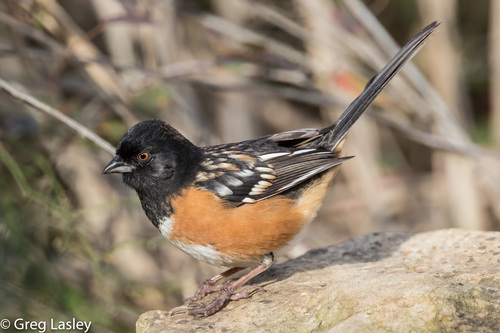
Spotted Towhee
The Spotted Towhee ( *Pipilo maculatus*) is a striking, large sparrow native to North America. Known for its bold black, white, and rufous plumage, it's a common sight in shrublands, thickets, and open woodlands, often heard scratching vigorously in leaf litter. It plays a crucial role in its ecosystem by dispersing seeds and controlling insect populations. While not a bird of significant cultural importance in the same way as some raptors or songbirds, its distinctive appearance and lively behavior make it a favorite among birdwatchers.
17-21 cm
Length
24-28 cm
Wingspan
Least Concern
Conservation Status
Distribution
The Spotted Towhee is found across western North America, from southwestern Canada through the United States and into Mexico. Its range extends from the Pacific coast eastward to the Great Plains. Some populations are migratory, moving south or to lower elevations for the winter, while others are year-round residents. They are not typically found at extreme elevations, generally residing below 8,000 feet.
Lifespan
The typical lifespan in the wild is unknown but estimated to be 3-5 years, with a maximum recorded lifespan of over 10 years in captivity. *Consult a professional for detailed data.*
Spotted Towhee's Habitat
Habitat Types
Shrublands, Thickets, Open woodlands, Chaparral, Forest edges, Riparian corridors, Suburban gardens
Climate Zones
Temperate, Subtropical, Mediterranean
Adaptations
Spotted Towhees have strong legs and feet adapted for scratching through leaf litter and dense underbrush, their primary foraging method. Their relatively short, rounded wings are suited for quick, agile flight within dense vegetation, allowing them to escape predators and navigate their complex habitat.
Variations
There are numerous recognized subspecies of Spotted Towhee (over 20), exhibiting variations in plumage color and size. Coastal populations tend to be darker, while those in the interior are often paler. These differences reflect adaptation to local environmental conditions.
Appearance
Breeding Plumage
Plumage is relatively consistent year-round, with males exhibiting a bold black head, back, and wings, contrasting with bright white spots on the wings and back, and rufous flanks. Females have similar patterns but are generally duller, with a dark brown or grayish-brown replacing the black.
Seasonal Feather Changes
Minimal seasonal variation; plumage may appear slightly brighter after molting.
Sex Based Plumage Differences
Males are more brightly colored with black upperparts, while females are browner.
Notable Features
Bright white spots on wings and back, Rufous flanks, Long tail, often flicked, Red eyes
Diet and Feeding
Primary Foods
Seeds, Insects, Berries, Small invertebrates
Foraging Behavior
Spotted Towhees primarily forage on the ground, using a distinctive "double-scratch" technique. They hop backward, simultaneously scraping both feet through leaf litter and soil to uncover seeds, insects, and other food items. They may also glean insects from foliage.
Specializations
Their strong legs and feet are specialized for their ground-foraging behavior. The bill is conical and robust, suitable for cracking seeds and handling insects.
Seasonal Diet Variations
Their diet shifts seasonally. In spring and summer, insects and other invertebrates form a larger proportion of their diet, providing protein for breeding and growing young. In fall and winter, seeds and berries become more important.
Behavior
Social Structure
Spotted Towhees are generally solitary or found in pairs during the breeding season. Outside of the breeding season, they may form loose flocks, but they are not highly social.
Communication
A sharp, distinctive "chewink" or "towhee" call, A complex song consisting of a series of trills and buzzes, Scratching sounds produced during foraging
Migration
Some populations are migratory, moving south or to lower elevations for the winter. Others are resident year-round. Migration patterns vary depending on geographic location and food availability.
Territorial or Group Behaviors
During the breeding season, males are highly territorial, defending their nesting area from other males. They use song and displays to establish and maintain territory boundaries.
Conservation
Threats
Habitat loss and fragmentation (due to urbanization, agriculture), Pesticide use (reducing insect prey), Predation by domestic cats, Window collisions
Protection Programs
Habitat restoration and conservation efforts, Promoting responsible pesticide use, Encouraging cat owners to keep cats indoors
Local National Laws
Protected under the Migratory Bird Treaty Act in the United States.
Population Trend
Stable
Population Estimates
The global population is estimated to be around 22 million individuals.
Interesting Facts
The Spotted Towhee was formerly considered the same species as the Eastern Towhee.
They were split into separate species in 1995 based on genetic, morphological, and vocal differences.
Their "double-scratch" foraging technique is unique.
This distinctive behavior helps them uncover food hidden in leaf litter.
Spotted Towhees can hybridize with Eastern Towhees
Hybrids are rare, and typically occur in areas where the two species ranges overlap.
Faqs about Spotted Towhee
What is the difference between a Spotted Towhee and an Eastern Towhee?
Spotted Towhees have white spots on their wings and back, while Eastern Towhees have unmarked backs and wings. Their songs and calls also differ.
Do Spotted Towhees visit bird feeders?
Yes, they may visit bird feeders, especially those offering seed mixes on the ground or in platform feeders.
Are Spotted Towhees aggressive?
Males can be aggressive during the breeding season when defending their territory, but they are generally not aggressive towards humans.
Copyright @ Nature Style Limited. All Rights Reserved.
 English
English